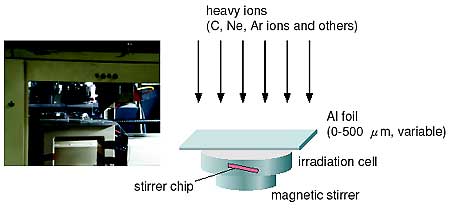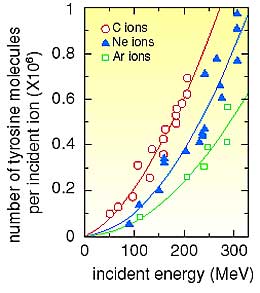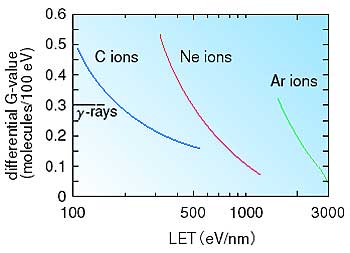In radiation chemical research, experimentally obtained yields have been generally reported using a G-value which is defined as the number of molecules produced per 100 eV of absorbed energy. Recently, ion beams of various types have become available and have taken the place of gamma-rays or fast electrons as reaction initiators. Radiation effects for different ion beams differ from each other in a complex way, and direct analysis using a G-value has become more and more difficult.
We have tentatively performed an analysis using a G-value differentiated in energy to represent the experimental yields. Fig. 9-1 shows the irradiation apparatus which was used. Ion-beams of 220 MeV C, 350 MeV Ne, and 460 MeV Ar ions were all generated by the AVF cyclotron at the TIARA facility, JAERI-Takasaki. Radiation-induced reactions of phenylalanine to form tyrosine isomers in aqueous solution were investigated, in which OH radicals produced by water radiolysis adduct to the phenyl ring of the reactant. Fig. 9-2 shows the yields of tyrosine molecules for different ions at varying incident energies. As is seen in the figure, the total number of tyrosine isomer molecules per incident ion increases more and more steeply as the ion energy increases. Since a conventional G-value is defined on the assumption that the yield depends linearly on the dose, the figure shows integrated (averaged) G-values. The present method of calculation gives G-values as a function of the energy of ions which irradiate the solution. These G-values have been determined by the slopes of plots of yield vs. energy curves. One can say that the values thus obtained contain more detailed information. The differential G-values thus obtained are shown in Fig. 9-3 against the LET (linear energy transfer) value, as is often used for presentation of results such as these. For any incident ion studied, the differential G-value decreases with increasing LET, while, at constant LET values, larger differential G-values appear for ions of higher atomic number. These results can be interpreted as due to different track structure (dose distribution around ion-path) for different heavy ions. The track structure for heavy ions has been studied theoretically as well as with experimental measurements using microdosimetric techniques. Our method refers it to actual chemical systems. The present results are thought to be the first such studies.
|



